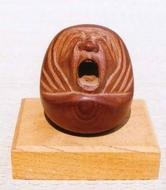:::::::::::::::::::::::::::::::::::::::::::::::::::::::::::::::::::::::::::::::::::::::::::::::::::::
Daruma Pilgrims Gallery
:::::::::::::::::::::::::::::::::::::::::::::::::::::::::::::::::::::::::::::::::::::::::::::::::::::
Kokubunji, Kokubun-Ji 国分寺

Kokubun Temple
The system of regional provincial temples everywhere in Japan (国分寺 Kokubun-ji for monks; 国分尼寺 Kokubun-niji for nuns) had been stablished by Emperor Shomu (Shoomu Tennoo (聖武天皇 Shōmu Tennō) (701 – 756) ).
He had the temple Todai-Ji (Toodaiji 東大寺) the "Great Eastern Temple" erected in Nara and the Great Buddha Hall (Daibutsuden) is the largest wooden building in the precincts of this central Kokubun-Ji.
. Shōmu Tennō 聖武天皇 Emperor Shomu Tenno .
The temple Hokke-Ji (法華寺 was the temple for nuns in Yamato/Nara.
It was built by the Emperess Komyo (Koomyoo (光明皇后, Kōmyō kōgō) (701-760) in 745).
waga seko to
futari mimaseba
ikubaku ka
kono furu yuki no
ureshikaramashi
Were my man
and I to view it together
how very much
this falling snow
would pleasure me.
Empress Komyo (701-60)
Tr. Bill Higginson
Empress Komyo was the consort of Japanese Emperor Shōmu (701–756).
She was also known as Asukabehime 安宿媛,
© More in the WIKIPEDIA !
Kokubun-ji (国分寺) were Buddhist temples established in each of the provinces of Japan by the Emperor Shōmu during the Nara period (710 – 794). Shōmu (701 – 756) decreed both a kokubunji to be established in each province for monks and a 国分尼寺 (kokubunniji) established for nuns. Tōdai-ji, the provincial temple of Yamato Province, served as the head of all kokubunji, and Hokke-ji held that duty for the kokubunniji.
The words "kokubunji" and "kokubunniji" gave rise to many place names still in use today, including:
Kokubunji, Kagawa
Kokubunji, Tokyo
Kokubunji, Tochigi
- quote wikipedia -
. Temple Hokke-Ji 法華寺 .
:::::::::::::::::::::::::::::::::::::::::::::::::::::::::::::::::::::::::::::::::::::::::::::::::::::
in the Daruma Museum
Somin Shorai 蘇民将来 だるま
Shinano Kokubunji Temple
Pilgrimage to 49 Temples of
Yakushi Nyorai in Western Japan
第17番 護国山 國分寺 Kokubun-Ji, Osaka 大阪市北区
Pilgrimage to 18 Fudo Myo-O Temples of Yamaguchi
十八不動三十六童子霊場
1番 浄瑠璃山 国分寺 Kokubun-Ji Shimonoseki
高野山真言宗 下関市南部町4-1
Juuniten Mandala 十二天曼荼羅図
Temple Kokubunji in Shimonoseki
Kuuya Shoonin, Kuya Shonin, (903-72) 空也上人
He became a monk at Kokubunji 国分寺 in Owari 尾張 (Aichi prefecture).
:::::::::::::::::::::::::::::::::::::::::::::::::::::::::::::::::::::::::::::::::::::::::::::::::::::
Kokubun-ji Daifuku 国分寺大福 Kokubunji-Dumpling
Mochi made whith white anko and mochigome rice.
Shizuoka Prefecture , 玉華堂 Gyokkado Store
:::::::::::::::::::::::::::::::::::::::::::::::::::::::::::::::::::::::::::::::::::::::::::::::::::::
H A I K U
国分寺すが洩り跡の堂の壁
kokubunji sugamori ato no doo no kabe
Temple Kokubunji -
the walls of the hall show remains
of leeking meltwater
Himori Mume 日守むめ
sugamori すが洩り (すがもり) leeking of melting icewater
:::::::::::::::::::::::::::::::::::::::::::::::::::::::::::::::::::::::::::::::::::::::::::::::::::::
Kokubun-Ji, Nr. 59. 国分寺
Shikoku Pilgrimage to 88 Temples
夏の寺 祈りと石に 癒されし
temple in summer -
the power of healing
in prayer and stone
Gabi Greve, Summer 2008
Photos are here.
:::::::::::::::::::::::::::::::::::::::::::::::::::::::::::::::::::::::::::::::::::::::::::::::::::::
国分尼寺静かに消えて白兎
Kokubun Niji shizuka ni kiete shiro usagi
nunnery Kokubun-ji -
a white rabbit disappears
ever so silently
Settsu Yukihiko 攝津幸彦 / 摂津 幸彦
1947 - 1996
Haiku Poet aus Hyogo.
国分尼寺守る杭打つ初仕事
Kokubun Niji mamoru kui utsu hatsu shigoto
first work of the year
to strengthen the piles
of nunnery Kokubun-ji
土屋尚 Tsuchiya Masa
. kui 杭 - kigui 木杭 Pile .
and all the nails 釘 kugi of Japan
.......................................................................
国分寺の在れば朧に国分尼寺
野見山ひふみ
国分尼寺天平の朱の草紅葉
Kokubun-Ji Tenpyoo no shu no kusa mojiji
町田しげき
初声の鶏を聞き立つ国分寺
門馬祥子
source : HAIKUreikuDB
:::::::::::::::::::::::::::::::::::::::::::::::::::::::::::::::::::::::::::::::::::::::::::::::::::::::::::::::::::::::::::
[ . BACK to DARUMA MUSEUM TOP . ]
[ . BACK to WORLDKIGO . TOP . ]
:::::::::::::::::::::::::::::::::::::::::::::::::::::::::::::::::::::::::::::::::::::::::::::::::::::::::::::::::::::::::::





